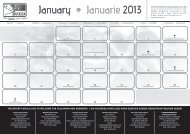Breed Standards - Sussex Cattle Breeders Society
Breed Standards - Sussex Cattle Breeders Society
Breed Standards - Sussex Cattle Breeders Society
Create successful ePaper yourself
Turn your PDF publications into a flip-book with our unique Google optimized e-Paper software.
37<br />
2.3.6 As the animal walks away, watch placement of its hind legs, its<br />
freedom of movement and balance. Assesss its size and growth.<br />
2.4 After this close examination, you should have an overall impression of the<br />
animal, together with a mental list of its strengths and weaknesses. Repeat<br />
the process with each animal in turn. The exhibitor deserves this courtesy<br />
from the judge, even in the case of animals which are obviously substandard.<br />
2.5 Skilled judges are able to indicate to the spectators that they have spotted a<br />
weakness on an animal. Try to put your hand on the problem area or in other<br />
ways to indicate to the spectators that you have seen the fault.<br />
2.6 Once you have examined each animal individually, let all the animals circle<br />
the ring once or twice. By now, you should have an idea of your placings.<br />
But it you are undecided, ask the steward to change the order to enable you<br />
to compare animals more easily. Do not waste too much time. Remember<br />
that first impressions are often the best, and that by delaying a decision for<br />
too long, you very often get into even worse trouble.<br />
2.7 Have the steward line up your selections in your order of preference; do not<br />
forget to line the animals up from the same end for each class.<br />
2.7 Compare the animals while they stand side by side. Do not hesitate at this<br />
stage to change the order if you are sure that you initial placing was wrong.<br />
But avoid continuous chopping and changing, especially with lower placings.<br />
Be thorough, but don’t waste too much time.<br />
2.8 It is always useful to parade the prize winners one more time before coming<br />
to a final decision.<br />
2.9 It there is a large class, it may be necessary to eliminate the worst animals,<br />
and let them go out of the ring before lining up your selections. It is in any<br />
case not necessary to place all the animals, it is usual to place one or two<br />
more than the number of available prizes, with the remainder being merely<br />
lined up behind the prize winners.<br />
2.10 It is not required that you award all the prizes available. If the standard is<br />
poor, you may decide for e.g. not to award a first prize. But this action should<br />
only be taken in extreme cases!<br />
2.11 Before indicating to the steward that you have finished, make a mental<br />
note of the reasons for your placings. Then while the tickets are written out,<br />
explain to the spectators why you have placed the animals in the order you<br />
have. Be brief, polite and considerate of the exhibitors, but be specific. If is<br />
not sufficient merely to say that “It is a very nice bull”! Apart from these<br />
remarks it is not wise to talk privately either to spectators or to the leaders.<br />
2.12 Apart from requests for information, or instructions concerning the<br />
parading and placement of animals, the judge should not discuss any animals<br />
with the steward.




